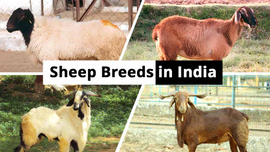Guide to Successful Buffalo Farming in India & its Economics

Table of Contents
- Overview of Buffalo Farming
- What is the Importance of Buffalo Farming in India?
- What are the Popular breeds of Buffalo in India?
- What is Ideal Housing Management in Buffalo Farming?
- What is the Best Feeding Management in Buffalo Farming?
- All about Buffalo Herd Health Management in Buffalo Farming
- Economics of a Buffalo Farm
Overview of Buffalo Farming
The domestic water buffalo (Bubalus bubalis) comes from the Bovidae family. Typically, they belong to two classes: river buffalo and swamp buffalo. Southeast Asia commonly accommodates swamp buffaloes, which are used in the form of draught animals. Their name is derived from their natural habitat of marshland or swamp. They are not employed to produce milk as their milk yield is low. India predominantly has river buffaloes that inhabit rivers and clean waters. Also, they are big in size with curled horns and are chosen mainly for milk production.
What is the Importance of Buffalo Farming in India?
There is no doubt that livestock is a key part of dairy farming in India. The livestock industry comprises integral buffalo farming, which provides over 50 million tons of milk and other high-valued resources for agricultural operations. A majority of milch breeds of buffaloes are found in the western and northern states. Also, there has been a steady rise in the number of buffaloes in India's total share of bovines. The share of buffalo milk in the total milk consumption is over 56%.
- Buffalo farming is a major source of livelihood and resources for the rural economy. Thus, it helps alleviate poverty and provides higher income for farmers from varying strata.
- Buffalo milk has 7 to 7.5% fat, which is why it draws higher market prices. This fat percentage is almost double that of cow milk.
- Buffaloes demand low maintenance comparatively. They can easily thrive in harsh climatic conditions with green forage and low-quality crop residues.
- India produces more than 65% of total milk obtained from buffaloes across the world and thus plays an important part in boosting the national economy.
What are the Popular breeds of Buffalo in India?
There are several buffalo breeds in India and the popular ones are:
- Murrah
- Jaffarabadi
- Surti
- Pandharpuri
- Mehsana
Other important breeds of buffalo in India are:
|
Breed |
Milk Fat (%) |
Average Lactation Milk Yield (kg) |
|
Chilika |
8.7 |
500 |
|
Bhadawari |
6-12.8 |
1,294 |
|
Toda |
8.2 |
500 |
|
Kalahandi |
8 |
680-912 |
What is Ideal Housing Management in Buffalo Farming?
A successful buffalo farm needs to have an adequate and well-planned housing facility. An ideal facility takes care of comfortable accommodation, suitable water supply, proper sanitation and clean milk production. Buffaloes can be reared in a loose housing barn or conventional buffalo shed. In the loose barn, the animals remain free unless there is a need for milking or treatment. A conventional buffalo shed is costlier and provides protection from harsh climatic conditions.
- The shed needs to be on higher ground so that rainwater and other waste can quickly drain without stagnation.
- The north side should have the maximum sunlight exposure, while the south should have minimum exposure. The shed should be protected from strong wind currents.
- The floor needs to be made of impervious material which is not slippery and easy to dry and clean.
- The platforms, mangers and gutters in the shed should receive direct sunlight.
- Asbestos sheets or tiles can be used for the shed roof. Iron sheets can reflect sunlight with aluminium-painted tops. The bottom of the sheets can be offered wooden insulated ceilings.
What is the Best Feeding Management in Buffalo Farming?
Effective feeding management can improve farm productivity and the potential of dairy animals. Water is highly important for various body functions like the maintenance of blood plasma volume, milk production and body temperature control. There is little water in cereals, hay and straw. Fresh grass and silage have around 70% water. The feed should have major nutrients like carbohydrates, vitamins, minerals, fat and protein for optimal production. According to ICAR, the nutrient requirements for milking buffaloes are:
|
Live Weight (kg) |
Energy (ME in Mcal) |
Total Crude Protein (g) |
TDN (kg) |
Phosphorus (g) |
Calcium (g) |
|
450 |
13 |
341 |
3.40 |
13 |
18 |
|
500 |
14.20 |
364 |
3.70 |
14 |
20 |
|
550 |
15.30 |
386 |
4 |
16 |
22 |
|
600 |
16.30 |
406 |
4.20 |
17 |
24 |
Also, the feeding schedule has been outlined below:
|
Breed |
Feeding Time |
Dry Fodder |
Green Fodder |
Concentrate |
|
Murrah (7-8 litre milk per day) |
Lactation days |
4-5 |
25-30 |
3.5-4 |
|
Dry days |
5-6 |
20-25 |
0.5-1 |
|
|
Surti (5-6 litre milk per day) |
Lactation days |
4-5 |
10-15 |
2.5-3 |
|
Dry days |
5-6 |
5-10 |
0.5-1 |
|
|
Mehsana (6-7 litre milk per day) |
Lactation days |
4-5 |
15-20 |
3-3.5 |
|
Dry days |
5-6 |
10-15 |
0.5-1 |
All about Buffalo Herd Health Management in Buffalo Farming
It is important to ensure suitable disease control and in-time treatment to derive optimum farm productivity. Following are some common diseases and control methods in buffalo farming:
|
Disease |
Symptoms |
Prevention |
|
Black Quarter |
Lameness, fever, and muscle twitching |
Tetracyclines, penicillin, antitoxicsera, sulphathiozole and active immunization |
|
Tuberculosis (TB) |
Harsh and dry cough |
Good ventilation, feeding and hygiene |
|
Haemorrhagic Septicaemia (HS) |
Nasal discharge, profuse salivation, rapid pulse, throat swelling, rapid heart rate, appetite loss and high fever |
Vaccination, disinfecting sheds and proper disposal of contaminated feed and water |
|
Buffalo-Pox |
Red spots and papules |
1:1,000 solution of potassium permanganate for cleaning lesions, antiseptic ointments like 1:110 boric acid |
Economics of a Buffalo Farm
The following section provides the cost-benefit analysis of a dairy farm with 10 Murrah buffaloes. Note that the figures are based on historical data and market research, and actual values may differ with factors like location, machinery used and labour.
|
Costs |
First Year |
Second Year |
Third Year |
Fourth Year |
|
Cost of Feeding During Dry |
8000 |
74000 |
76000 |
68000 |
|
Cost of Feeding During Lactation |
153000 |
212000 |
214000 |
230000 |
|
Veterinary Aid & Breeding Charges |
10000 |
11000 |
12000 |
13000 |
|
Labour & Wages |
54000 |
57000 |
60000 |
63000 |
|
Insurance Charges |
15000 |
14000 |
14000 |
13000 |
|
Total Costs |
240000 |
368000 |
376000 |
387000 |
|
|
|
|
|
|
|
Sales |
|
|
|
|
|
Milk Sales |
495000 |
720000 |
765000 |
864000 |
|
Gunny Bag Sales |
2000 |
3000 |
3000 |
4000 |
|
Total Sales |
497000 |
723000 |
768000 |
868000 |
|
|
|
|
|
|
|
Gross Profit |
257000 |
355000 |
392000 |
481000 |
India has a large buffalo population, which supports the livelihood of the dairy farmers. Buffalo farming not only generates subsidiary income for farmers but also provides additional resources like draft power and manure. It is a lucrative business and has excellent potential for employment generation. Follow this guide to start a successful buffalo farm and earn high profits.


Related Blogs












